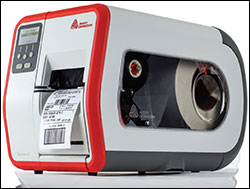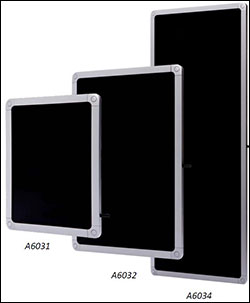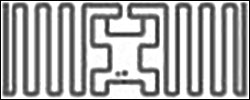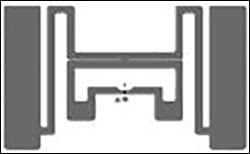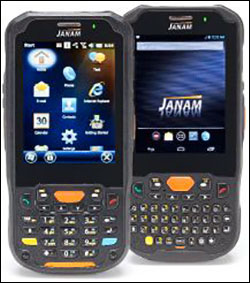Jan 22, 2015The following are news announcements made during the past week by the following organizations:
Avery Dennison RBIS;
IDTronic;
SecureRF;
DecaWave;
Checkpoint Systems; Nedap; and
Janam Technologies.
New Avery Dennison RBIS Printer Supports Faster Label Printing, RFID Encoding, Data Verification
Avery Dennison Retail Branding and Information Solutions (RBIS) has announced its new Monarch tabletop ultrahigh-frequency (UHF) RFID encoder and bar-code printer (thermal direct or thermal transfer). The new Avery Dennison Tabletop Printer 1 (ADTP1) is designed to serve a range of marking applications. It was built to accelerate bar-code and RFID label and tag printing, encoding, verifying, cutting and stacking, RBIS reports, so companies can better move merchandise quickly and accurately through the supply chain. The printer's optional RFID encoder and verifier modules are compatible with the EPC Gen 2 and ISO 18000-63 standards.
The ADTP1 features a fast processor that offers print speeds of up to 12 inches per second (ips), a large internal supply capacity that can reduce the need for roll changes by as much as 50 percent, non-stop RFID encoding and verification at 8 ips, a three-color backlit display for instant visual identification of printer status, and support for dual-band 802.11 a/b/g/n. The printer's optional RFID data verifier is designed to overstrike bad RFID labels and tags, and to immediately alert the operator. Other features include auto-correct capabilities, dual motor ribbon control and an enhanced media-sensing system.
The tabletop device measures 13.8 inches (351 millimeters) in height, 11.5 inches (292 millimeters) in width and 21.5 inches (546 millimeters) in depth, and weighs 32 pounds.
IDTronic Unveils Two New UHF RFID Antennas
IDTronic, an RFID hardware provider based in Germany, has announced new multi-purpose circular-polarized RFID antennas and a linear-polarized doorframe antenna. All operate in the 864 to 869 MHz and 902 to 928 MHz ultrahigh-frequency (UHF) ranges.
The multi-purpose antennas are available in three sizes: the A6031 measures 275 millimeters by 214 millimeters by 12 millimeters (10.8 inches by 8.4 inches by 0.5 inch) and weighs 0.6 kilogram (1.3 pounds), with a read range of up to 4 meters (13.1 feet); the A6032, measuring 391 millimeters by 275 millimeters by 12 millimeters (15.4 inches by 10.8 inches by 0.5 inch) and weighing 1 kilogram (2.2 pounds), has a read range of up to 6 meters (19.7 feet); and the A6034, at 747 millimeters by 314 millimeters by 12 millimeters (29 inches by 12.4 inches by 0.5 inch) and 2.2 kilogram (4.9 pound), offers a read range of up to 9 meters (29.5 feet).
The antennas have an IP65 rating, meaning that testing has confirmed them to be dustproof and waterproof, and they can withstand operating temperatures ranging from -20 degrees to +55 degrees Celsius (-4 degrees to +131 degrees Fahrenheit). They have integrated mounting holes and are designed to blend easily into any industrial environment or office and retail space, iDTronic reports.
The A8060 is a low-profile flat-panel antenna 8 millimeters (0.3 inch) in thickness, designed to easily transform existing doorframes and doorways into an RFID portal or read point, making it suitable for such applications as crowd management, hospital-patient identification and asset tracking. The antenna features integrated mounting holes for ease of installation. It can be mounted on the left, right or top side of a doorway, the company indicates, and when combined with a ground antenna, such as iDTronic's A6590C, its performance can be boosted.
SecureRF Announces Secure NFC Tag Featuring PKI Authentication
SecureRF, a security solutions provider for the Internet of Things (IOT), has announced the availability of its LIME Tag NX01, a secure Near Field Communication (NFC) tag that utilizes Public Key Infrastructure (PKI) technology. The security technology in the tag is designed to deliver identification and authentication solutions that require no database or Internet connectivity when performing an authentication, according to the company. It is suitable for credentials and authentication solutions, including item-level brand protection and anti-counterfeiting for pharmaceutical, spirits, electronics and fashion products.
Available as an inlay, card or chip for integration into existing products, labels or tags, the passive NX01 provides a dual interface option for both contact and contactless deployment. Both interfaces—ISO 7816 and ISO 14443—are supported when using the contact power mode. The NX01 can also be utilized as a contactless card or tag; in this mode, the NX01 can be used with most NFC-enabled smartphones or readers, and is supported by SecureRF's Veridify smartphone app—which, in addition to authentication, can provide visual verification, location and messaging features.
The PKI security features address a wide range of commercial applications, including credentials, product and brand protection, and other high-value transactions. According to SecureRF, the tag utilizes SecureRF's Algebraic Eraser, a public key (asymmetric) linear-in-time crypto engine running directly on the tag, along with industry-standard security protocols, in order to deliver authentication and data-protection functions and make the tag uncloneable. The Algebraic Eraser is a Diffie-Hellman method that runs on a passive NFC chip with no additional co-processors or connections.
The NX01 provides up to 100 kilobytes of protected user-defined data and incorporates many PKI elements, including the ability to revoke or un-revoke its certificate of authenticity, via the smartphone or user app—in essence, turning the tag's authentication on or off after deployment. SecureRF also provides an easy-to-use cloud-based dashboard for data management and reporting.
DecaWave Launches Partnership Program for UWB Micro-Location Technology
DecaWave, a fabless semiconductor company specializing in ultra-wideband (UWB) technology for precise location and connectivity applications, has announced the formation of its partnership program. The program is aimed at creating an ecosystem that can share the expertise of the hardware vendors, software developers and systems integrators using DecaWave's location technology to increase time to market.
DecaWave's technology consists of UWB RFID chips and modules designed to be built into active RFID tags, transceivers, machines or electronic shelves for unique, low-cost real-time location system (RTLS) applications. DecaWave's DW1000 chips and DMW1000 modules comply with the IEEE 802.15.4-2011 (UWB PHY) standard. Tags made with DecaWave chips can act as transceivers, and can be set up to create a wireless sensor network (WSN) and RTLS solutions. The DW1000 technology operates at data rates of 110 kilobits per second, 850 kbps and 6.8 mbps, and can locate tagged objects, both indoors and outdoors, with 10-centimeter (4-inch) accuracy.
According to DecaWave, micro-location applications are necessary in a variety of industries, including health care, factory automation, logistics and retail, and the market is expected to grow by 30 percent year over year during the next five years. The DecaWave technology is designed to make micro-location affordable to even the smallest businesses, the company reports. DecaWave's partners, through the new program, will be able to offer a wealth of technical and application expertise, design cost-effective tailored solutions and provide off-the-shelf solutions for shorter time to market and lower development efforts.
According to DecaWave, five companies—U.S.-based Ciholas, IDOLink (based in South Korea), German company Agilion, U.S.-based Redpoint Positioning and WoxuWireless, in China—are already signed up as partners, and others are expected to be announced soon.
Checkpoint Systems Debuts New ARC-Certified RFID Labels, Updates POS Solutions
Checkpoint Systems has announced new RFID labels certified by the Auburn University RFID Lab's ARC testing system. The company has also announced additions to its Counterpoint iD (CPiD) point-of-sale (POS) deactivation solutions, designed to address the needs of specialty apparel and department stores for merchandise visibility and loss prevention.
The new Zephyr 3 and Breeze RFID labels have integrated Ucode 7 chips from NXP Semiconductors, and come with optimal read-write sensitivity for accurate counting and quicker encoding. The Zephyr 3, measuring 50 millimeters by 30 millimeters (2 inches by 1.2 inches), and the Breeze, measuring 42 millimeters by 16 millimeters (1.7 inches by 0.6 inch), have been optimized for performance with all of Checkpoint's RFID solutions, including its RFID EAS Overhead Solution, the Evolve Exclusive E10 pedestal and others from the company's suite of Merchandise Visibility solutions. Both have received certification from the Auburn University RFID Lab's ARC program for the newly created M category in North America, which includes denim, polybagged apparel, hanging apparel and footwear. This, according to Checkpoint, allows retailers to use the same tag across much of their merchandise, streamlining their source-tagging operations.
Extending its existing Counterpoint iD-RF electronic article surveillance (EAS) solution—which deactivates RF-EAS labels at the point of sale and can be used at manned checkouts and self-checkouts—Checkpoint is introducing Counterpoint-RFID (CPiD-RFID) and Counterpoint iD Dual (CPiD-Dual) for RFID and dual RF/RFID POS deactivation needs, respectively.
The CPiD-RFID and CPiD-Dual solutions enable retailers to process RFID tags at the point of sale for better merchandise visibility, by triggering reorders or restocking when necessary. The solutions also allow RFID-based EAS functionality, either by altering the data encoded to a label's RFID chip, or by "virtual deactivation"—a process by which the item is uniquely identified as sold in the inventory system, so that the alarm at the exit door does not sound, without the need for altering the label's data itself. A patented antenna at the point of sale is designed to prevent nearby RFID labels from being read, written or killed, to significantly reduce stray reads and improve POS accuracy. The CPiD-Dual system also allows for simultaneous RF-EAS deactivation and RFID processing at the same location, and is suitable for retailers that are transitioning from traditional EAS to RFID and may be operating some or all of their stores in a mixed-label environment.
The CPiD-RFID and CPiD-Dual solutions are designed to process RFID tags by connecting to a POS system via a UPOS driver, explains Nimesh Shah, Checkpoint's global senior director. The CPiD-Dual solution also has a single pad, or antenna, at the point of sale that can be used to deactivate both RF-EAS and RFID labels simultaneously. In addition, there are on- and under-counter pad options for retailers.
Nedap Opens U.S. Office to Accelerate Growth in the Retail Sector
Nedap, a manufacturer of security and inventory-management solutions for retailers, has announced the opening of a U.S. sales office in the New York area for its retail division. The opening is part of a long-term expansion plan designed to bring Nedap closer to its U.S. customers and partner network, the company reports. The U.S. presence also will enable Nedap to shift its focus from servicing global accounts to successfully partnering with national American accounts. Dannie Klompsma has been appointed the area director for North America, in order to shape and extend the U.S. operation.
According to the company, setting up the U.S. office is the initial step toward establishing a full American headquarters for the retail division. The headquarters will include sales, engineering and marketing teams, and a partner training center to provide partners with maximum local support and business resources.
"It is essential for Nedap to be closer to the market and our partners to really make a difference in the U.S, retail market," Klompsma said in a prepared statement. "After several years of continuous growth in the U.S., we decided to establish a logistic hub in Boston in 2013, in addition to our hubs in Europe and Asia. This U.S. office is the next major milestone in our commitment to the U.S. market."
Nedap's portfolio for the American retail sector consists of loss-prevention and stock-management solutions, designed to help retailers optimize their in-store merchandise availability and permanently reduce losses caused by customer theft, internal fraud and administrative errors. Nedap develops hardware and software in the field of RF- and RFID-based electronic article surveillance (EAS), RFID-based stock management, visitor counting and access control.
Retailers such as Dutch shoe manufacturer and retailer Wolky is employing Nedap's RFID-enabled inventory- and retail-management system with integrated Nedap RFID labels embedded with a passive ultrahigh-frequency (UHF) EPC Gen 2 inlay (see Dutch Shoe Company Wolky to Affix RFID Labels on Shoeboxes During Production).
Janam Intros Rugged RFID-enabled Mobile Computer With Multi-OS Support
Janam Technologies, a provider of rugged mobile computers that scan bar codes and communicate wirelessly, has launched its XM5 family of RFID-enabled rugged mobile computers. The XM5 supports Microsoft Windows Embedded Handheld 6.5 and Android operating systems on the same hardware, allowing customers to choose the OS and application migration schedule that best meet their mobility requirements.
Customers can choose between a 1D/2D imager or 1D laser scanner. The XM5's built-in high-frequency (HF) RFID reader can interrogate passive 13.56 MHz tags complying with the ISO 14443 or ISO 15693 standards.
The XM5, the company reports, is one of the few rugged mobile computers that allow a customer to migrate from Windows to Android without purchasing new hardware. The XM5 comes with either a QWERTY or numeric keypad, as well as a fortified 3.5-inch VGA display that withstands heavy-duty use. It also offers 802.11a/b/g/n dual-band wireless local area network (WLAN) and 4G-ready UMTS/HSDPA/HSUPA/GSM wireless wide area network (WWAN) communications.
Designed for such applications as inventory management, asset tracking, personal identification and mobile point of sale, the XM5 is sealed to IP65 standards (signifying it as being dustproof and waterproof), can withstand five-foot drops to concrete and is UL-certified for use in hazardous environments. In addition, the handheld ships with a 4000 mAh rechargeable lithium-ion battery, providing extended battery life.

